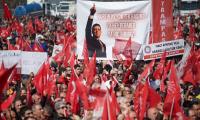Karachi
After leading the recent four day pro-Mumtaz Qadri sit-ins at Islamabad’s D-Chowk and Karachi’s Numaish Chowrangi, the Sunni Tehreek has emerged as the country’s leading radical Barelvi group, attracting the aggressive religious activists in a large numbers.
Although activists of Barelvi groups are comparatively passive in street agitation, political analysts believe the driving force behind the protests was ST rather than the Tehreek-e-Labaik Ya Rasool Allah, an alliance of several little-known Barelvi groups.
Journalists in Islamabad said ST workers from Karachi were seen overseeing the protest.
A Rangers-led crackdown in Karachi has weakened the ST as several of its activists have been arrested for their involvement in criminal activities in the city.
Rangers have raided the ST’s headquarters several times and confiscated their records. They also interrogated the group’s head, Sarwat Ejaz Qari, and his deputy, Shahid Ghauri, at the Rangers headquarters during the latter’s “brief detention”.
However, security analysts believe that the Qadri issue has given a new lease of life to the outfit after it led the recent protests in Islamabad and Karachi.
‘Defenders of mosques’ to militancy
The ST, which was recently renamed the Pakistan Sunni Tehreek, was formed in 1990 to prevent the mosques and madrasas of the Barelvi school of thought in Karachi from being “captured” by Deobandi and Ahle Hadith groups.
A veteran journalist said the ST had distinctive features, operating as a religious group presenting the Barelvi school of thought and at the same time, a militant group fighting with the Muttahida Qaumi Movement and the rival sect-based groups, particularly the Ahle Sunnat Wal Jamaat.
He added that the ST’s organisational grid was similar to that of the MQM – having sectors and units.
“Both groups [the ST and the MQM] are involved in a turf war after the former emerged as a challenge to the latter’s political domination in the city,” he told The News.
“Both parties draw their support from lower-income Urdu-speaking communities.”
According to a U.S Consulate cable dated April 22, 2009, released by Wikileaks, the ST is militarily “disproportionally powerful” because of the influx of the MQM-Haqiqi gunmen inot the outfit after the government crackdown.
Owais Tohid, a senior journalist familiar with the workings of religious parties, said the ST in the beginning used the slogan “Jawaniyan lutaain gai, masjidain bachayein gai [We will sacrifice our lives to protect our mosques]”.
“But recently, the group started following the trend of radicalisation, making it difficult to differentiate between them and jihadist groups,” he maintained.
Analysts believe Barelvi groups; especially the ST, have started politically exploiting the issue of blasphemy and the execution of Qadri has provided them with an opportunity to show their strength to counter the growing influence of Deobandi and Ahle Hadith groups in the country.
Safdar Sial, a research analyst at the Pak Institute for Peace Studies, an Islamabad-based think tank, believes that all religious groups can be equally violent and extremist if one touches their sensitive issues.
“So the traditional narratives of the Barelvis being followers of Sufism, peace-loving and moderate become irrelevant when one touches blasphemy-related issues,” Sial told The News.
Tohid concurs. “Now the ST’s new slogan is ‘Tauheen rasalat ki ek saza, sar tan se juda (There’s only one punishment for a blasphemer and that is beheading),” he noted.
New leadership
In April 2006, the central leaders of the ST including Abbas Qadri, Iftikhar Bhatti, and Akram Qadri, were killed in a bomb attack during a congregation at Nishtar Park in Karachi.
Analysts say that with its top leadership killed, the ST cannot be seen as a moderate outfit with its new generation.
Tohid said the ST’s new leadership negated the impression of being moderate when they led violent protests during the Danish cartoon controversy and the blasphemous film saga.
“Encouraged by the size of attendance in their protests, they are now flexing their muscles and making Qadri a hero to lay the foundation of a new radical fort in Pakistan,” he added.
“With the establishment now after the Taliban, Al Qaeda and other militant outfits which mostly follow Deobandi and Ahle Hadith schools of thought, the ST sees an opportunity to lead the Barelvis into becoming an acceptable replacement.”
On the ‘watch list’
In January 2002, the then president Gen (retd) Pervez Musharraf announced that the ST was being placed on the watch list. Five other extremist groups - the Jaish-e-Mohammad, the Lashkar-e-Taiba, the Sipah-e-Sahaba Pakistan, the Tehreek-e-Jafaria Pakistan, and the Tanzeem Nifaz-e-Shariat-e-Muhammadi - were banned.
A law enforcement official participating in the ongoing crackdown in Karachi said ST was one of the key groups involved in extortion cases and violence in the city.
“The ST is a sectarian group that has an organised network of armed criminals mainly involved in extortion cases and targeted killings,” he added. “It has turned into a militant group.”
The ST has been facing internal rifts in recent times. Ejaz Sarwat Qadri heads the more powerful faction of the group, which has recently renamed itself as the Pakistan Sunni Tehreek.
Muhammad Bilal Qadri, the son of ST founder Saleem Qadri, has formed his own faction after developing differences with Sarwat Ejaz Qadri and other leaders.
An illuminated view of a mosque decorated with colorful lights. — INP/FileSpecial Dua and spiritual congregations...
Pakistan’s former foreign secretary and international affairs expert Najmuddin A Sheikh seen in this image,...
Senior Minister Sharjeel Inam Memon chairs a high-level meeting of the Sindh transport and mass transit department on...
Students are going to their school for the first day after the summer vacation in Larkana. — APP/FileThe Sindh...
A police personnel stands alongside Kamran Asghar Qureshi, father of Armaghan Qureshi on March 20, 2025. —...
A representational image showing an ambulance parked at an incident site. — AFP/FileUnidentified suspects threw a...







